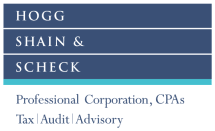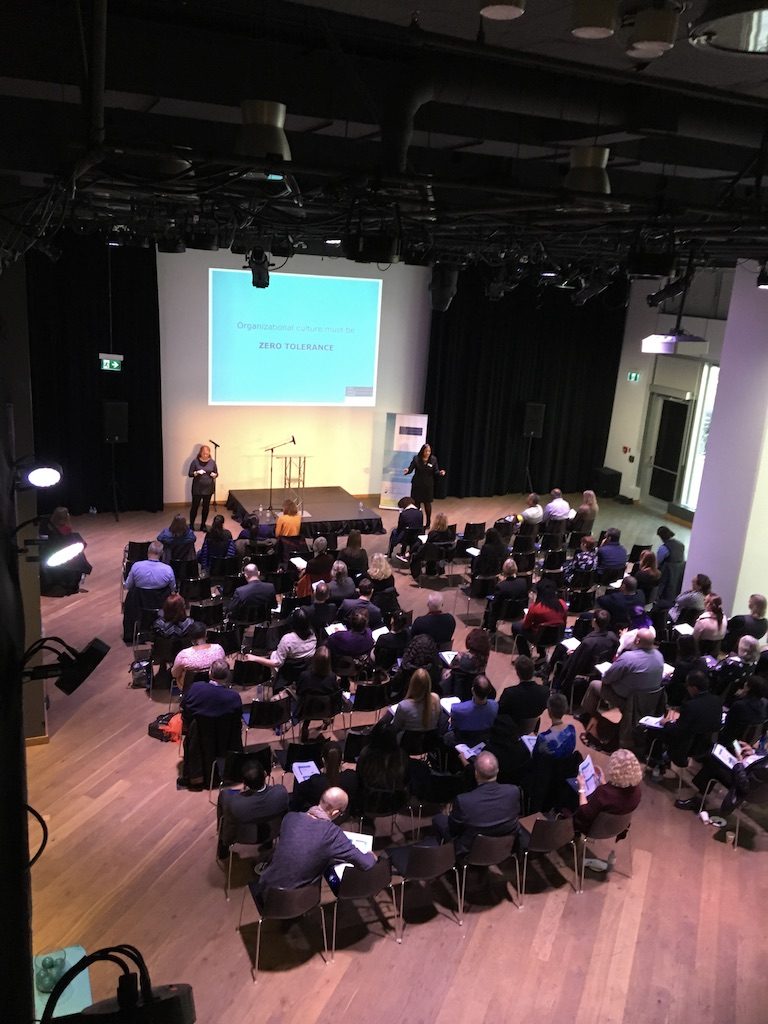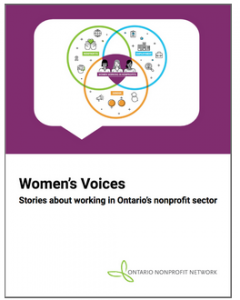Operating in a #MeToo Context – Charities and Not-for-Profit Organizations
Summary
- Why this sector is particularly vulnerable
- What the law says
- The role of the Board
- The role of management
- Anti-harassment policy and program
- Addressing complaints
- Training
Beyond sexual harassment:
- Harassment includes:
- Sexual
- Bullying (though has no legal grounds)
- Verbal abuse
- Discrimination
- Up to the person who alleges harassment to say whether it is harassment or not
People are people, and sometimes people make big mistakes
An issue that requires no explanation: Organizations in this sector are particularly vulnerable to a #MeToo crisis

Not-for-profit culture:
- A sector known for having the nicest, kindest people
- Conflict-avoidance
- Behavioural latitude
- Limited resources means a focus on programming
Demographics:
ONN surveyed 730 women:
- Sector consists of 80% women workers
- Sexism – 46.4%
- Some form of discrimination – 48.4%
- Unsure – 11.6%
More statistics: Federal government: Survey of 1,350 federal staff in Feb/Mar 2017
Of respondents: 75% reported most recent incident, 41% said nothing was done to address abuse
- 60% experienced harassment at work
- 30% experienced sexual harassment
- 21% experienced violence
- 3% experienced sexual violence
Priority to keep overhead costs down
- Human resources department
- Whistleblower systems
- Keeping “bad apples” is cheaper
- Risk of losing knowledge
- Time to deal with allegations
Poor policing
- Training of employees and volunteers
- Investigating complaints
- Disciplining bad behaviour
- Not following policies
- Not notifying local authorities

Ontario’s Occupational Health & Safety Act: Workplace harassment:
Engaging in course of vexatious comment or conduct against a worker in a workplace that is known or ought reasonably to be known to be unwelcome
Ontario’s Occupational Health & Safety Act: Sexual harassment
Engagement in course of vexatious comment or conduct against a worker, in a workplace because of sex, sexual orientation, gender identity or gender expression where the course of comment or conduct is known or ought reasonably to be known to be unwelcome
OR
Making a sexual solicitation or advance where the person making it is in a position to confer, grant or deny a benefit or advancement to the worker and the person knows or ought reasonably to know the solicitation or advance is unwelcome.
Ontario’s Human Rights Code
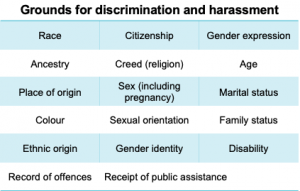
Under Bills 168/132
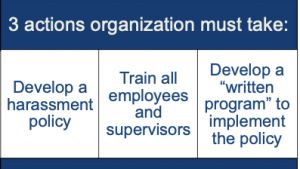
The role of the Board

The role of the Board: SET
- Tone from the top
- Adequate anti-harassment & misconduct policies and procedures for staff and the Board
- Seek legal review
- Anti-harassment statement as part of organization’s core values
- Safe reporting system
- Crisis response plan
The role of the Board: RECEIVE
- Background check reports for key management, Board/Committee members, volunteers
- Critical to maintain reputation of organization
- Training / orientation for new members and have all directors attend
- Annual signed declarations:
- To abide by code of conduct
- Conflicts of interest
- Report on complaints
The role of the Board: CHECK
- Policies and procedures are being followed
- Policies and procedures are effective and relevant
- Governance / Nominating Committee has established vetting process
- Adequate insurance is in place
- Directors & Officers Liability
- Other Adequate reserves for contingencies
The role of management: EXECUTE
- Ensure policies are easy to read and understand
- Enforce policies
- Communicate the tone at the top
- Create a work environment that is
harassment-free - Promote workplace psychological health
- Make it clear that everyone is accountable, even Board members
- Provide training and education
- Measure how values are lived
- Encourage timely reporting of incidents
- Ensure complaints are:
- Received
- Addressed
- Seek feedback from employees / volunteers
- Report to the Board

Example of cover-up
- Lesson learned: Don’t just cover it up. It will come to light, and it will make your organization look bad and you’ll be worse off.
- Discipline abusers of the police with a zero tolerance attitude – people are watching how you react. React well, they’ll learn not to contravene the policy. Sweep it under the rug, and staff/volunteers will learn that’s the kind of working environment this is.
- Will lose top talent, and sector is struggling to find talent, period.
Anti-harassment policy must
- Be prepared by employer
- Clear define what constitutes harassment
- Be compliant with the law
- Posted in a conspicuous place
- Reviewed at least annually
Anti-harassment policy must include statements:
- Employer’s commitment to addressing harassment
- Policy applies to all workers
- Addresses all sources of harassment
- Reasonable management is not harassment
- Employer will investigate incidents/complaints
- No penalization or reprisal against employees who report or participate in investigation
Anti-harassment program must state:
- Safe reporting system = no barriers
- Individual to report to, including who to go to if employer/supervisor is harasser
- How complaints will be responded to, investigated, addressed
- Confidentiality
- Employee will be informed in writing of:
- Results
- Corrective action
But go read it over – make sure it is comprehensive and covers all the bases. Make sure it continues to be effective and relevant. Focus especially on what the policy says about how complaints will be handled
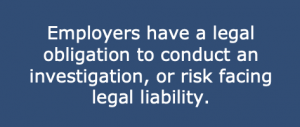
Addressing complaints
Timely
- Immediately protect employees from harassment pending investigation
Responsive
- Conduct a thorough investigation of complaint
- Fair and reasonable process
- Inform all parties of results
Corrective
- Enforce policies
- Ensure harassment stops
Set this before a crisis occurs -An organization may not have time to think in a stressful time. If you don’t follow proper process, you could be opening your organization up to a lawsuit.
What does a “fair” process look like?
- Person feels heard and respected
- Complaint was addressed promptly
- Neutral, unbiased process
- Decision based on full information
- Confidentiality maintained
- Will hold up in court

Whistleblower program ≠ open-door policy
Smaller organizations are particularly vulnerable
- Lack of time
- Lack of resources
- Familiarity in the team could result in biases
- Harasser could be in leadership position
- Loss of evidence
Shield your organization from liability with a real whistleblower program
A whistleblower program includes:
- Formality
- Clarity in how / who to report to
- Trained investigators: Law, psychology, assessing credibility, formulating conclusions
- Neutrality
- Confidentiality
- Anonymity
- Investigation
- Steps for dealing with false complaints

Training is key
- What harassment, bullying, verbal abuse, and discrimination are
- Unacceptable behaviour
- Consent
- HR policies & procedures
- Consequences
- What to do in the moment:
- Injured party
- Witnesses
- Those receiving complaint
- When/Who/How to report incidents
- Effective training is:
- Simple to deliver
- Tests comprehension
- Tracks completion
STEPS TO HANDLING A CRISIS
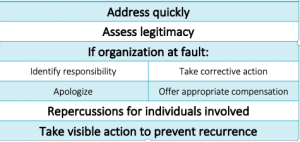
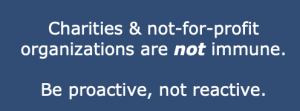
- Some organizations may need a complete transformation of culture. It’s not hopeless. Start with best practices, and the tone at the top to make a cultural shift a priority.
- Some organizations already have a lot of this in place, but go back and assess what you might be lacking:
- Are policies unclear?
- Are you confident employees/volunteers even know what the policies are?
- Do you have many new people?
- Do you need to bake into your annual plan some annual training on these matters?
- In a sector that is having enough challenges attracting top talent, take action on these matters so you can both retain your good people and recruit more good people.
Published from Presentation Charities & Not-for-Profit Organizations, Hogg, Shain & Scheck CPAs on October 30, 2018, at the HSS Navigating for Social Impact at Artscape Sandbox
Disclaimer: This presentation does not constitute formal professional advice. The contents are for general information purposes only and under no circumstances can be relied upon for legal decision-making. Attendees and readers are advised to consult with a qualified accountant and obtain a written opinion concerns the specifics of their particular situation.
Resources
- https://theonn.ca/wp-content/uploads/2018/10/Womens-Voices-October-2018.pdf
- http://www.imaginecanada.ca/blog/timesup-your-directors-addressing-anti-harassment-board-level
- https://www.ragan.com/5-key-takeaways-from-starbucks-crisis-response/
- https://charityvillage.com/cms/active-learning/webinars/past-webinars/five-things-you-need-to-know-about-harassment-investigationshttps://charityvillage.com/cms/Portals/0/CharityVillage/Webinars/Harassment_Investigation_Slides.pdf
- https://www.advocatedaily.com/forensic-restitution-investigator-unearths-false-claims-of-harassment.html
- http://www.nortonrosefulbright.com/knowledge/videos/165260?utm_source=vuture&utm_medium=email&utm_campaign=18-10-16%20motion%20episode%204%3a%20workplace%20policies%20_25%20october%202018
- https://www.ontario.ca/page/code-practice-address-workplace-harassment
- https://www.ontario.ca/page/code-practice-address-workplace-harassment#section-7
- https://www.ontario.ca/page/code-practice-address-workplace-harassment#section-8
- https://www.theglobeandmail.com/report-on-business/careers/leadership-lab/understanding-and-employing-bill-132-in-the-workplace/article32231651/
- https://globalnews.ca/news/3992737/bill-c-65-what-does-it-do/
